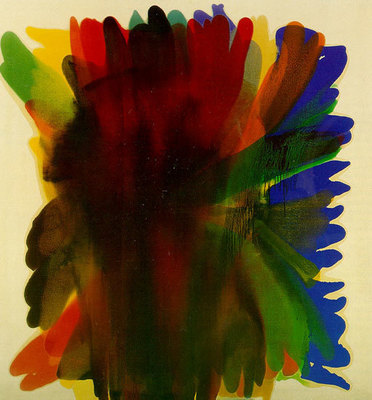
Description
Morris Louis, born in 1912, belonged to the same generation as the early Abstract Expressionists. His painting, however, is more closely associated with that of the younger-generation color-field painters Helen Frankenthaler, Kenneth Noland, and Jules Olitski.
Louis is best known for the work he produced after 1953. Before that, his painting went through a Cubist phase, followed by a period strongly influenced by Jackson Pollock. In 1953, however, with Noland and the influential critic Clement Greenberg, Louis paid a visit to Frankenthaler's studio that precipitated a major transformation in his work. Frankenthaler at that time was using a technique derived from Pollock's drip paintings that involved pouring and staining color into raw canvas. In 1954 Louis began pouring thinned pigment over large pieces of canvas, allowing it to drip downward, forming streaks of color that mixed on the surface and sometimes created pools at the bottom. The first group of poured paintings became known as "veils." From this point on, Louis's paintings attracted the attention of Formalist critics such as Greenberg and Michael Fried. He was lauded for liberating color from the constraints of drawn boundaries. The staining procedure made the paint inseparable from its canvas support. At the same time an illusion of purely optical color was produced. This simultaneous acknowledgement and denial of the literal flatness of the picture surface was, according to Greenberg, one of the essential elements of modernist painting. Louis's process eliminated any sign of the artists hand, so obvious in Abstract Expressionist gestural painting, and, according to Fried, Louis's paintings took on "the appearance, or illusion, of a sovereign impersonality"
After the veils, Louis created three major series of paintings before his sudden death from lung cancer in 1962. These included the "florals," the "unfurleds", and the "stripes". As his paintings evolved, Louis increased the amount of control he exerted over the flow of paint, and used more intense, opaque color. Aleph Series IV is considered one of the florals, although the Aleph series, consisting of nine paintings, forms a semi-independent group. InIV, as in the other eight paintings, bright colors have been poured so that they mix, forming a brownish area in the center of the canvas. Unifying the image, the brown paint flows over the brighter, radiating bands of color as it moves with the force of gravity toward the bottom of the picture plane. Unlike the configurations in some of the other Aleph paintings,the colored image in IV seems to flow off the canvas. Reproducation of this image, including downloading, is prohibited without written consent from the Estate of the Artist or by contacting the Curatorial and Tour Services Office at 518-473-7521.
Details
- Work Date:
- 1960
- Location:
- Corning Tower Concourse Lobby
- Dimensions:
- 8'-3" x 8'-9 1/2"
- Medium:
- Acrylic on canvas